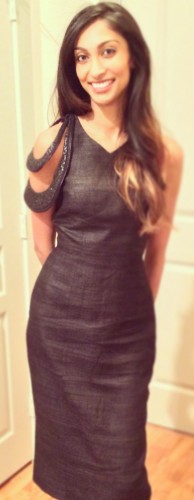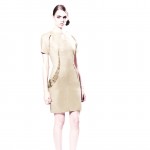One of the first articles we ever did on Brown Girl was to highlight an aspiring fashion designer, named Malati Vasudevan. At the time, she had just finished up college and was navigating the fashion world, but I decided to interview her because like so many other Brown Girls, she was taking a career path that is not conventional in the South Asian community.
Almost six years later, it’s great to catch up with Vasudevan to see how she’s doing on the eve of the launch of her first collection under her brand Mala Vasu. I asked Vasudevan to reflect on her path, her dream and how it’s finally coming to life.
“When I first told my family my career choice of being a fashion designer, they assumed it would be a hobby rather than a viable career,” Vasudevan said.
“Even though they were uneasy in regards to designing, when it came time to apply for colleges my parents’ advice was to take on a dual degree of Business and Fashion. Their advice paid off. I was able to gain knowledge on the principles of business which has helped me so much in my venture.”
Mala Vasu started as a dream, and even with a degree in fashion and business, Vasudevan was unsure of exactly where to begin or how to make her dream a reality. It was her parents that gave her the support she needed in order to initially get her footing in the industry.
“Few parents I know would fully emotionally and financially support their only child in moving and living in NYC to pursue their dreams right after graduation the way my parents have. They have worked so hard to provide me with everything and more. Making my parents proud and being able to share my success with them is what inspires and motivates me daily,” Vasudevan said.
“It has also been amazing to have my parents who are always so excited and supportive for me to achieve my dreams. Faith, perseverance, and an unparalleled support system of family and best friends have helped me feel anything is possible.”
Vasudevan explains that moving to NYC and finding her footing in the world of fashion was a character building experience. She quickly realized that in order survive and thrive in the industry she had to be willing to give 200 percent. She had graduated when the economy had just taken a nose dive and the fashion industry was especially hard hit.
“Through one unpaid internship after another, I truly learned the meaning of ‘paying your dues’. It was a lonely struggle sometimes but my conviction in pursuing my dreams, and faith in the universe moving me towards it kept me afloat,” mentions Vasudevan.
Within a few weeks of starting her first job she was able to attend an event for the Council of Fashion Designers in America with her boss who was a member. The CFDA is the most elite group within the fashion industry and to be nominated and inducted into its ranks is a rare privilege and honor.
“Surrounded by the top icons of the fashion world it only reinforced my dreams to be one amongst them one day. As my boss and mentor once told me ‘I don’t know how to be anything else’,” said Vasudevan.
I asked Vasudevan what advice she would give other aspiring fashion designers.
“Once your goals are set, my advice is to always keep focus, surrounding your life with people that positively move you forward to achieving those dreams. Words cannot describe that moment you realize you’re doing exactly what the universe meant for you to do.”
Photo credit: Morgan Chidsey
Be sure to check out the entire Mala Vasu Spring 2015 Collection by visiting their website and lookbook. ‘Like’ their page on Facebook, follow them on Instagram, and email them: info@malavasu.com.
[divider]
 About Mala Vasu:
About Mala Vasu:
Mala Vasu is a contemporary womenswear line that focuses on sustainable luxury and chic, striking silhouettes. Our inspiration comes from women who live life with their unique standard of individuality, quality, and responsibility, aiming to create a positive footprint in the world. Mala Vasu holds itself to that standard using only the highest quality organic textiles and skilled workmanship to create pieces that are not only intricately beautiful and unique but also ecologically responsible.
Our ‘Ahimsa’ (non-violent) silk is produced without killing or harming silk worms or any other animal or plant life. Our handspun fabrics are dyed using zero-impact dyes that are completely harmless to the environment. We believe beauty should exist inside and out, and the way we do business should reflect the pieces we design.
Much like the layers of a beautiful work of art, the vision of MV encompasses and embraces the same evolution and complexity. An idea is transformed into a sea of texture, shapes and color that narrates the inspiration behind each design. Building a luxury brand that promotes the well being of the planet along with social responsibility by using locally sourced and hand woven fabrics, helping skilled artisans keep traditional skills alive, and working only with like minded vendors are essential to our business philosophy.
Each piece in the MV collection is a labor of love and dedication; the collection is our story and work of art.








